
THE SMOKED-FOODS
COOKBOOK
STACKPOLE
BOOKS
Published by Stackpole Books
An imprint of Globe Pequot
Trade Division of The Rowman & Littlefield Publishing Group, Inc.
4501 Forbes Boulevard, Suite 200, Lanham, Maryland 20706
Distributed by NATIONAL BOOK NETWORK
800-462-6420
Copyright 2018 Lue Park and Ed Park
All rights reserved. No part of this book may be reproduced in any form or by any electronic or mechanical means, including information storage and retrieval systems, without written permission from the publisher, except by a reviewer who may quote passages in a review.
British Library Cataloguing in Publication Information available
Library of Congress Cataloging-in-Publication Data
The hardback edition of this book was previously cataloged by the Library of Congress as follows:
Park, Lue
The smoked-foods cookbook : how to flavor, cure, and prepare savory meats, game, fish, nuts, and cheese / Lue Park and Ed Park
1st ed.
p.cm.
Includes bibliographical references and index. ISBN 0-8117-0116-6
1. Smoked meat. 2. Smoked fish. 3. Cookery (Smoked foods)
I. Park, Ed. II. Title. TX609P27 1992
641.4'6dc20 92-7047
CIP
ISBN 978-0-8117-0116-7
ISBN 978-0-8117-1999-5 (paperback)
ISBN 978-0-8117-6750-7 (e-book)
 The paper used in this publication meets the minimum requirements of American National Standard for Information SciencesPermanence of Paper for Printed Library Materials, ANSI/ NISO Z39.48-1992.
The paper used in this publication meets the minimum requirements of American National Standard for Information SciencesPermanence of Paper for Printed Library Materials, ANSI/ NISO Z39.48-1992.
Printed in the United States of America
To Tracy, Kelly, and Jeff, who could consume jerky and smoked fish faster than we could make it
INTRODUCTION

Smoke-flavored foods command such high prices at markets, delicatessens, and specialty stores that they are often reserved for special occasions. But you can enjoy such foods as smoked salmon, dried jerky, or a smoke-cooked roast anytime you wish once you have learned to make these foods at home with a minimum of space, effort, time, and money. Most types of meats can be smoked, and a smoky flavor can be added to many other foods, including pasta, beans, cheese, and nuts.
Smoking is not an exact science, but it requires experimentation. Such variables as climate and equipment will influence the result. More important, personal tastes vary: what is too sweet or salty for one person will be just right for another.
Smoking foods has a long history. Although we dont know for sure, man probably learned to smoke meats shortly after he discovered fire. We all know from campfire experiences that smoke repels insects. This repellent quality became clear to us when we were on a wilderness pack trip several years ago. We rode horses, while a string of mules carried our gear. At the end of each day, we turned the horses and mules loose to feed on the lush grasses. Then we set up camp, prepared and ate our meals, and gathered around the evening fire.
It was summer, and biting insects swarmed around the livestock, causing them extreme discomfort. We soon noticed that every time we had a fire, two of the mules would walk over and stand with their heads in the heaviest of the smoke. Although the smoke seemed to irritate their noses and eyes, evidently they were less bothered by the smoke than by the insects.
No doubt early man also stood in the smoke of fires to keep insect pests away. Eventually, he may have realized that if smoke kept insects off himself, it would do the same for his meat. Smoking offered another advantage: it also helped in the preservation process. At some point, he must have decided he liked the flavor of smoked meat, too. Anthropologists speculate that early man did not need salt because he got plenty from the raw meats he ate. When he started cooking meat, however, the salt was leached from the meat, so he had to add salt to his diet. He discovered that salt not only enhances the flavor of foods but also acts as a preservative.
Once he knew how to dry and salt meat, he could preserve it indefinitely. When meat was plentiful, he could dry it and store it for future use; when times were lean, he had a supply of food to sustain him until the next hunt produced more fresh meat.
Until the advent of refrigeration in the late 1870s, salting was the primary method of preserving meats. Smoking played an important part in this curing process. As freezers became more widely used and cooking with wood or coal became less common, the art of smoking foods fell by the wayside. People still loved the flavor of smoked food, however. A new quick-cooking process using charcoal briquettes came into vogue, and soon, most American families had some type of barbecue grill. For additional smoky flavor, hard-wood chips were added to the hot briquettes, or liquid smoke flavoring to the marinade or sauce. The production of fine old-fashioned smoked foods was left largely to the commercial specialty houses. Dry and semidry sausages, ham, bacon, and smoked fish were available only in the deli section of grocery stores or at gourmet food stores.
Of course, a few people such as farmers and avid hunters and anglers, still cured and smoked foods. Yet even these people lacked the space and time required for smoking in traditional smokehouses. Soon, the need for an easier, more economical way to smoke foods was evident.
Companies began to build electric smokehouses, which quickly became popular in many areas of the country. These smokers, or smoke ovens, as they are called, produce hot-smoked foods such as smoked fish and jerky, and add smoke flavors to many other foods.
Today, smoking foods can be as simple or as sophisticated as you want it to be. Most people use some method of hot-smoking, since it is the quickest and easiest way to add a smoky flavor to a wide variety of foods. Those who have the time and the space may opt for a smokehouse, where meats can be cold-smoked using a more controlled and lengthier process. Regardless of the method, however, we now have the means to produce mouth-watering flavors in smoked foods.
BASIC PRINCIPLES
W hen we think of smoked meats and other foods, we usually think of flavor first, then preservation. The moister, more lightly salted foods produced today are more palatable than the heavily salted and very dry foods of the past. Remember, however, that heavily salted and dried foods are preserved; todays lightly salted and less dry foods need to be treated as perishable.
There are a number of reasons people choose to smoke foods at home. Doing it yourself is far less costly than buying the finished product. It is a simple, easy process that produces wonderful results. And you can control the salt, sugar, and fat content of your own smoked foods, as well as experiment with herbs and other flavorings.
Advance preparation of food for smoking varies. Cheese and nuts can be smoked without much preparation. Meats and fish are usually marinated or cured before smoking.
Cures are necessary for preserving many kinds of smoked foods, especially meats and fish that are cold-smoked. Salt provides a certain amount of safety in preservation, depending upon how much is used. Although curing salts do not usually have to be added to most meats that are hot-smoked, many people like to add some to the brine or dry cure for the flavor they impart. (See Preparing Foods for Smoking.)
Next page


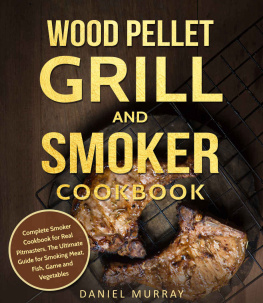
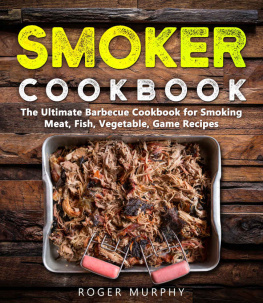
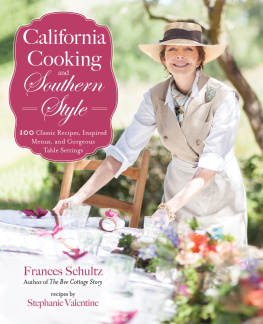
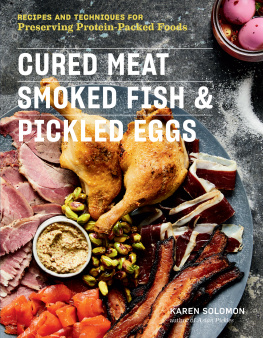

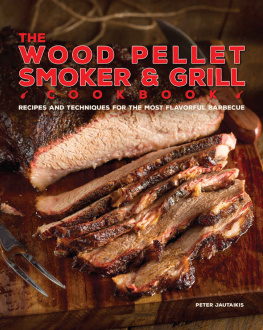

 The paper used in this publication meets the minimum requirements of American National Standard for Information SciencesPermanence of Paper for Printed Library Materials, ANSI/ NISO Z39.48-1992.
The paper used in this publication meets the minimum requirements of American National Standard for Information SciencesPermanence of Paper for Printed Library Materials, ANSI/ NISO Z39.48-1992.